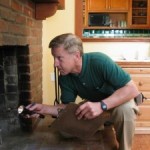Once winter’s chill hits the Buffalo and Rochester area, you may not even have to wait for snow to fire up your fireplace or wood stove. But you should definitely wait until you’ve performed a chimney, fireplace and wood stove inspection to prevent fires and ensure all components are ready for action.
Chimney Check
The chimney is an ideal place to start your Western New York fireplace and wood stove inspection, as it can be the source of several hazards.
- Look over the exterior: Here you want to ensure the chimney is not leaning or pocked with cracks, holes, chipped or missing masonry and bricks. Metal chimneys should be free of stains and corrosion.
- Check the chimney cap: A chimney cap with a quality screen mesh is essential for keeping out snow, rain and wildlife while ensuring sparks and embers don’t end up on your roof.
- Examine the interior: Inspect the area around the chimney inside your home, looking for any evidence of leaks, dampness or stains. Signs of water around the chimney can indicate faulty flashing at the roof line or a damaged flue liner. Either requires immediate professional attention.
- Inspect the flue: Open the door at the base of the flue, looking inside with a small mirror and flashlight. Check for a buildup of soot as well as holes, separations or cracks. Also keep an eye out for creosote, which is a flammable byproduct of burning wood formed by wood tar, moisture buildup and organic vapors. Regularly check for creosote buildup, having it removed if it reaches one-eighth of an inch or more.
Firebox Review
Keep your Western New York home’s fires burning bright – and safely – with a review of your fireplace.
- Check the brickwork and doors: Examine the fireplace’s brickwork for signs of damage or wear. If your fireplace has glass doors, clean them while looking for any cracks. Ensure the door gaskets have a tight seal.
- Test the damper: Open and shut the damper, which is the metal plate that separates the firebox from the flue. Open and close it several times to make sure it’s functioning properly.
Wood Stove Inspection
Wood-burning stoves are another way to add extra warmth as well as charm to your Buffalo area home, and they have their own maintenance checklist.
- Examine stovepipes: Make sure the stovepipes are firmly secured to the stove, and they are free of any cracks that can result in the escape of toxic fumes into your home’s interior. Stovepipes should be cleaned out before the first seasonal use, and replaced if they show any signs of deterioration.
- Check for cracks and corrosion: Examine the entire exterior of the stove, keeping a keen eye out for signs of rust, corrosion or cracks. Pay special attention to the stove’s legs and body. Periodically check stovepipes for holes, loose joints and corrosion throughout the season.
- Look over safety features: Ensuring your floor and wall is properly protected against the stove’s heat is a must, as is making sure the stove’s door gasket has a tight seal.
One final check is to make sure your carbon monoxide and smoke detectors have working batteries and any home fire extinguishers are in working order. Maintenance checks of your chimney, fireplace and wood stove are integral steps to prevent fires, helping to ensure you and your family have a warm, cozy and safe winter season.
Lastly, it a good idea to have your fireplace or wood stove professionally cleaned and inspected at least once a year. Do not leave the safety of your family to chance; a professional has the tools and training to spot trouble areas as well as access hard to reach areas at the top of your chimney.



